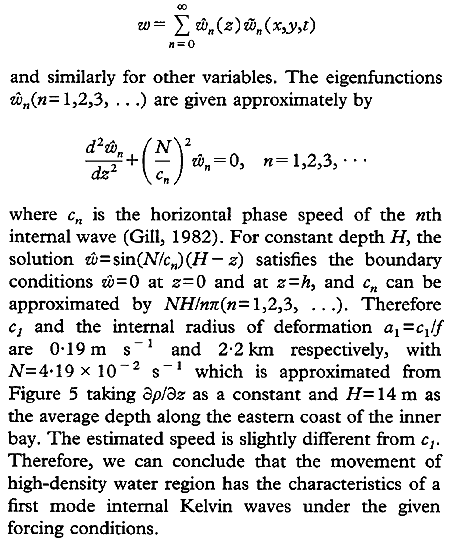This is interpreted as follows. The up-welling and downwelling regions caused by the wind can move as forced internal Kelvin waves with the land on the right (Suginohara, 1974). In the bay head, the upwelling region moves toward the west along the coast, but the downwelling always dominates near the western edge of the bay head, so the upward current toward the west is cancelled out due to the downward current. This process can be considered as formation of a steady state by the forced internal Kelvin waves (Clarke, 1977; Kitade et al., 1998). The density distributions obtained from the computation are very similar to the observed temperature and salinity distributions, i,e. the higher density region of the eastern side of the inner bay corresponds to the low temperature and high salinity area in Figure 3.
Before the steady state is attained, the movement of the high-density water in the middle layer is estimated as the phase velocity along the eastern coast of the inner bay. The speed of this region is 0・15 m s-1 from Animation 1. This can be verified as the phase speed of an internal Kelvin wave, as follows. Under the constant buoyancy frequency N, the vertical velocity w for the separable solution as a sum of normal modes has the form

Animation 2 shows the density distribution and velocity fields for the transverse section along y=40 km from the origin, near the centre of the bay. The density contour lines in the upper layer of the eastern side of the bay rise up and the dense water outcrops to the sea surface after approximately one inertial period from the beginning of computation. The density contours are almost horizontal in the middle layer and those in the bottom layer slope down towards the north-west, i.e. the reverse slope to those in the upper layer. The density field strongly indicates the presence of internal modes of motion, as already seen in the current field. Actually, the north-westward current (negative μ) is limited within 3 m depth, and a weak south-eastward current (positive μ) is formed from 3 m to 15 m depths except at the eastern coast. In addition, the transverse current (υ) is very weak in the bottom layer. The distribution of the along-bay velocity across this section shows the outward flow in the upper layer and the inward flow in the middle and lower layers. The surface outward flow is confined to within 10 m depth from the sea surface, and its maximum depth appears at the western side. On the other hand, the inward flow in the middle and lower layers has a core at about 13 m depth near the centre of the bay. The core depth of the compensatory flow in the middle layer against the surface current, i.e. the eastward current in transverse circulation and the inward flow in axial section, are different from each other. The shallowness of the circulation in the trans-verse section is believed to suppress the water exchange between the surface- and lower-layer waters in Tokyo Bay in summer. Therefore, anoxic water is abundant near the sea bottom for long time periods during every summer, as seen in Figure 2.
Response of the bay to real wind observed in the summer of 1979
As a next step, we try to compute the response of the ocean to the observed wind in Tokyo Bay and to confirm whether or not the observed current and temperature are reproduced by application of our numerical model. The current and density distributions obtained from TOBEX in the summer of 1979 are used and the wind data at Yokohama are also used. In this case, the values of AH and Av are given as 1・0 × 104 m2 s-1 and 1・0 × 10-4 m2 s-1 respectively from preliminary runs, and the value of CD is selected below:

with a smooth transition for wind speeds between 7 and 10 m s-1 (Csanady, 1982).
The results obtained from the numerical experiment are shown in Animation 3. The currents and the density distributions at the surface (0・5 m depth), middle (7・5 m), and lower (14・5 m) layers are illustrated from 18 to 26 July 1979.